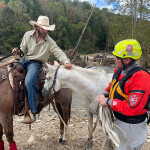The Equine Disease Communication Center (EDCC) has reported recent Strangles outbreaks in horses across Florida, Michigan, Ontario, Pennsylvania, and Washington. In this article, we’ll explore what Strangles is, how it spreads, the available treatments, and the best prevention methods to protect your horses.

Strangles - the name might sound alarming if you're a first-time horse owner, but don’t panic. This condition, caused by the bacteria Streptococcus equi, is essentially the equine equivalent of strep throat in humans. While strangles can cause painful abscesses in the lymph nodes, along with other uncomfortable symptoms for your horse, it is rarely fatal. With the right treatment and preventive care, your horse can recover fully and may even avoid contracting it altogether in the future.
This guide will walk you through everything you need to know about strangles, from how it spreads to treatment options and prevention strategies. Whether you're a seasoned equestrian or new to horse ownership, understanding this illness is an essential part of keeping your horses and your equestrian community healthy.
Table of contents [Show]
- What is Strangles and How is it Spread?
- Recognizing the First Signs and Symptoms
- Horses Most at Risk of Strangles
- Containing Strangles
- How Severe is Strangles?
- How Often Does it Lead to Death?
- Treating Strangles
- Recovery Time and Contamination Period
- Is There a Vaccine for Strangles?
- Why Proper Management Matters
- What Horse Owners Can Do Next
What is Strangles and How is it Spread?
Strangles is a highly contagious bacterial infection transmitted through contact with infected horses or contaminated environments. Horses contract strangles when they come into contact with nasal discharge, pus from draining abscesses, or objects like water buckets, feed troughs, grooming tools, or tack used by an infected horse.
Herd living situations often exacerbate the spread. Once one horse in a communal stable or field is infected, the close quarters make it easier for the bacteria to jump to others. Keep in mind, Streptococcus equi can survive in the environment for weeks, particularly in damp and shaded areas.
Simply put, strangles spreads quickly, which is why containment measures are critical.
Recognizing the First Signs and Symptoms
The early signs of strangles can sometimes mimic other minor illnesses, so it’s important to stay vigilant. Here’s what to watch for in your horse:
- Fever (often the first sign, usually 103°F or higher)
- Swollen or enlarged lymph nodes, particularly around the throat
- Nasal discharge, initially watery and later thick with pus
- Reduced appetite or complete lack of interest in food
- Increased difficulty swallowing or noisy breathing
If you notice these symptoms, it’s wise to contact your veterinarian for assessment and testing immediately. Early intervention not only improves your horse's recovery but helps limit the spread of the disease.
Horses Most at Risk of Strangles
While any horse can contract strangles, some factors increase susceptibility:
- Young horses (less than five years old) are particularly vulnerable due to underdeveloped immune systems.
- Horses kept in crowded settings or that regularly travel to events expose themselves to a higher risk of infection.
- Horses dealing with stress, poor nutrition, or other illnesses may have compromised immune systems, reducing their resistance to bacterial infection.
Containing Strangles
If a horse in your care contracts strangles, your primary goal should be to limit exposure to other horses. Here are some steps you can take:
- Immediately isolate the infected horse in as far-removed a location as possible.
- Avoid sharing feed buckets, water troughs, or grooming tools between the infected and healthy horses.
- Implement strict disinfection protocols for any equipment or materials exposed to the infected horse or its discharge.
- Wear gloves and change clothes if you’re handling both the infected and healthy horses. Cross-contamination through humans is common.
- Notify local horse owners, barns, or event organizers to prevent unwitting exposure beyond your property.
An outbreak of strangles can devastate equestrian communities, so transparency and preventive measures are vital for protecting the broader horse population.
How Severe is Strangles?
While strangles is rarely life-threatening, the health and well-being of your horse can take a significant hit. Most infected horses will feel noticeably sick, with a fever, reduced appetite, and lethargy lasting several days.
In severe cases, swelling can become so intense that it compresses the windpipe, leading to labored breathing—hence the name "strangles." Although rare, a life-threatening complication known as "bastard strangles" can occur. This condition arises when the infection spreads beyond the lymph nodes in the head and neck to other parts of the body, such as the abdomen, chest, or vital organs. While most cases of strangles resolve with proper care, the development of bastard strangles demands immediate and advanced veterinary treatment to manage widespread abscesses and prevent further complications. This highlights the importance of early detection and prompt treatment in effectively managing equine illnesses.
How Often Does it Lead to Death?
The good news is that strangles typically has a low mortality rate—less than 10% of cases result in death, and most infected horses will recover fully with proper care. Death is usually due to complications like abscessed infections in other organs or severe airway obstruction. By acting quickly and consulting your vet, you can reduce your horse's risk dramatically.
Treating Strangles
Treating strangles hinges on the severity of the infection. Here’s how it’s generally approached:
- Rest and Isolation: Provide the horse with a quiet, comfortable space away from other animals where it can fully recover.
- Abscess Treatment: Abscesses often require drainage. Your veterinarian may lance and clean these to ease the horse’s discomfort and facilitate healing.
- Anti-inflammatory Medications may be recommended to reduce swelling and make swallowing easier.
- Antibiotics could be prescribed in certain instances, especially when complications arise. However, these are avoided in early cases as they may interfere with the immune system's natural response to fight the infection.
Always follow your vet’s instructions closely and monitor your horse’s progress during treatment.
Recovery Time and Contamination Period
On average, horses take 2 to 4 weeks to recover from strangles. That said, recovery varies based on individual horses and the severity of their symptoms.
Once symptoms subside, an infected horse can remain contagious for weeks—even when no longer visibly ill. To prevent secondary outbreaks, it's crucial to confirm that your horse is no longer shedding the bacteria, generally verified through a series of negative nasal swabs performed by your veterinarian.
Is There a Vaccine for Strangles?
Yes! Vaccines for strangles are available and can lower the risk of infection. They work by helping your horse’s immune system build defenses against Streptococcus equi.
Vaccines are highly recommended to protect horses, especially those at higher risk of exposure to diseases like strangles. They play a crucial role in building immunity by preparing the horse’s immune system to recognize and fight off infections more effectively. For horses that frequently travel, compete, or are exposed to new environments and other horses, vaccination can significantly reduce the risk of illness and outbreaks. Speaking with your veterinarian is always the best approach to determine whether your horse requires or would benefit from vaccination against strangles, based on their health, lifestyle, and risk factors.
Why Proper Management Matters
Strangles isn't just a hassle for you and your affected horse—it can ripple through your barn, community, and even region if uncontained. Maintaining vigilance, practicing strict biosecurity, and keeping open lines of communication with fellow horse owners can prevent outbreaks and protect the well-being of the broader equestrian community.
Every outbreak averted is a win for animal welfare.
What Horse Owners Can Do Next
Strangles can seem intimidating, but with quick action, proper care, and a commitment to preventive measures, you can minimize its impact on your horse and community.
If you're concerned about strangles or need advice on managing it, consult your veterinarian and discuss topics like vaccination and barn biosecurity. Together, we can create a healthier, safer environment for our equine companions.








